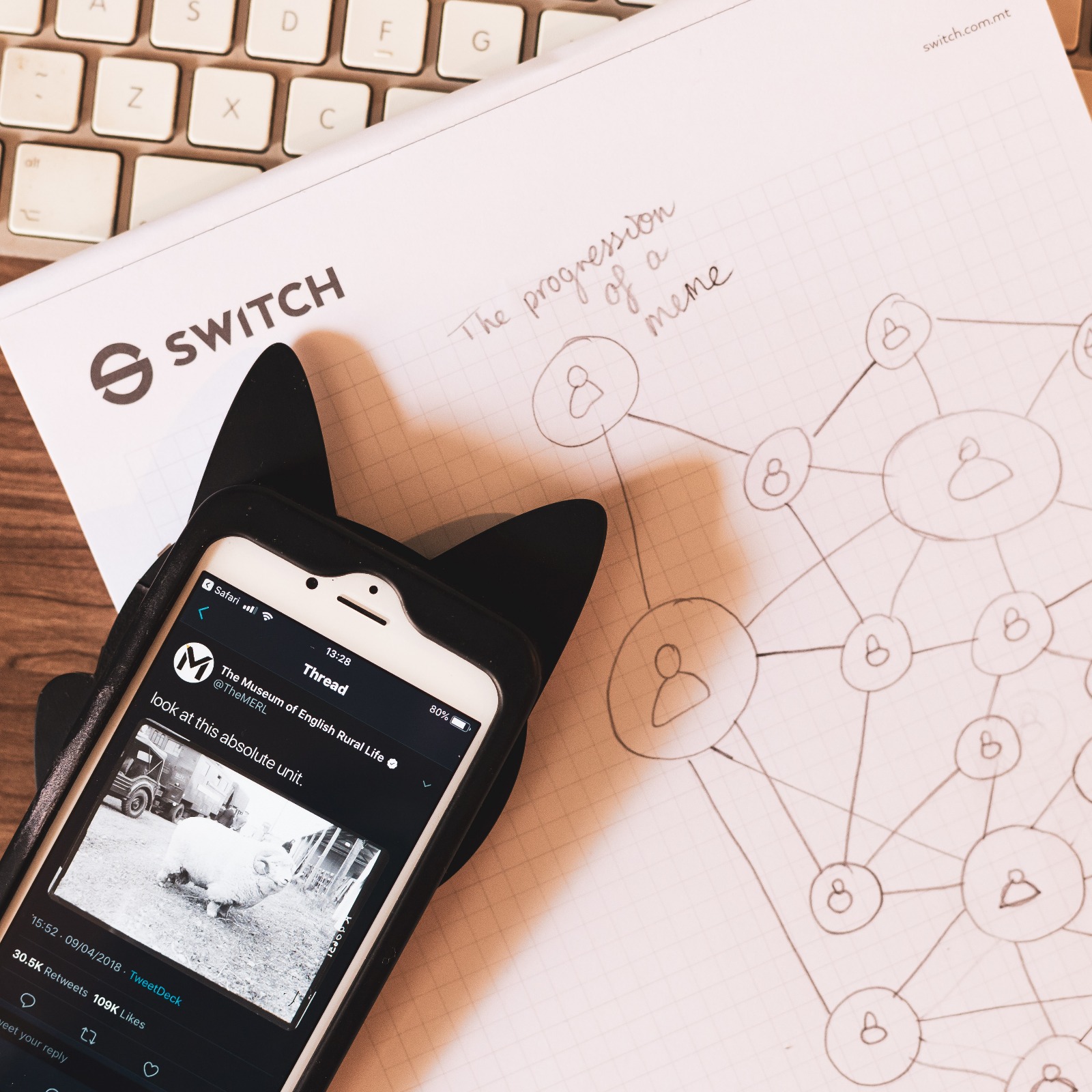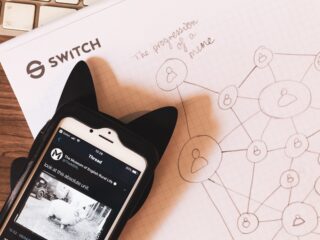One of the most common requests we get from clients is ‘I want something that will make my brand go viral’. They come to us starry-eyed with dreams of posting a perfectly-worded caption, video, image, or blog that will take the internet by the horns and splash them on every news site in the Googlesphere. People will retweet, repost, reshare, and like their medium, their company will grow, they can quit their job in Malta and move from Sliema to Portomaso, and the rest of their life can be spent milking that one viral post that sent them skyrocketing for the stars.
It’s a beautiful, beautiful dream, and we would love to offer it to you!
Unfortunately, while Mike may have mastered the art of mind-reading and Matt is very good at trend-spotting, the reality is that no-one can promise you content that will ‘go viral’. Content that will ‘go viral’ isn’t usually content that will ‘go viral’ to begin with; it’s just content. Nobody wakes up in the morning, sits down at a keyboard, and shits out content that racks up views hand over fist (if there is, please apply, because our copywriter was born in the 1950s and her knowledge of memes is at least three generations old).
But—
You may be looking at the Switch blog right now and saying, “but XYZ company/coworker/influencer on Youtube says they can make me go viral, here’s six thousand pages of reviews that say so.”
They are lying. They are most definitely, definitely lying.
Yes, there are techniques and sciences and things in common.
Obviously, if you post 2000 things a day, you will stumble upon that one thing that will work (the more likely scenario is that you’ll annoy all your clients posting incessantly, so please do not do this unless you run a Minions fan page; with Minions, more seems to be better).
Here’s the thing though: those aren’t secrets, and they’re not really something you should pay for.
Viral content is unplanned. Viral content can go unnoticed for years before someone changes it slightly, reposts it under their own name, and it takes off. Viral content is unpredictable: what was popular an hour ago is now cringy and cliche, and you’re out of date for keeping up with it.
Viral content is not a feasible promise that any company can make to you, and we’re going to break down why by tackling the most viral posts from 2018.
Memes
Memes are funny, easy to share, relatable, and anyone can join in, so if you have an absurdist sense of humour and you’re good at applying jokes to pictures, memes are a good way to test your creative limits. Brands can piggyback on memes (sometimes not very successfully – we’re not naming names) and raise their awareness just by stripping down the corporate layer and Getting To Grips with its viewers, however more likely than not brands who engage in memes will do it wrong, and then get torn apart by the internet.
Sheep. Sheep everywhere.
Here’s an example of a corporation piggybacking on a meme successfully:
look at this absolute unit. pic.twitter.com/LzcQ4x0q38
— The Museum of English Rural Life (@TheMERL) April 9, 2018
(we apologise if you’ve heard of this before. Our copywriter is obsessed with sheep, particularly fat sheep).
Real talk: have you heard of the Museum of Rural English Life before? No peeking at the internet, it’s just you and me, we’re all friends here — no? Neither had we, until this ram showed up like a glorious chubby beacon, heralding a bright spot of light in our Monday routine.
Everyone loved it. The image was liked 98,000 times and retweeted 27,600 times in 72 hours, which the MERL leveraged into greater attention by posting a follow-up tweet with extra information about the ram, t-shirts, a gif. It eclipsed the original meme, which was a not-so-nice poke at a hotelier, to become a wholesome image people forwarded to everyone for the greater good.
The MERL milked it for all it was worth, and occasionally they post more fat sheep, so it’s a win-win situation for everyone, and the world is a slightly brighter place. However, nobody predicted the way it would take the internet by storm.
Why did it work? Adam Koszary, the MERL’s then social-media manager, and now digital lead, put it succinctly:
And why it went viral doesn’t take rocket science. It’s a good photo, a cute animal and a relevant use of a meme. Throw in a few lucky retweets from influencers, and we were away.
Note the use of the word ‘lucky’.
Keep that in mind. That one’s important.
And now for something completely different…
If you’re a fan of Mark Wahlberg, you might want to ‘thank you, next’ this entire section and pretend it’s a collection of his greatest moments or something, because our copywriter is rolling up her sleeves and wiping off her colour-coded makeup to work in as many scathing remarks as possible.
Earlier in 2018, completely-real-human-being-and-not-an-alien Mark Wahlberg posted his daily schedule. It starts at 2:30AM, an hour where most people would reasonably still be asleep, but when you’re a semi-successful actor who can demand over $1 million for reshooting the same amount of scenes as your female co-star, time no longer has meaning.
Here’s the rest of the schedule:
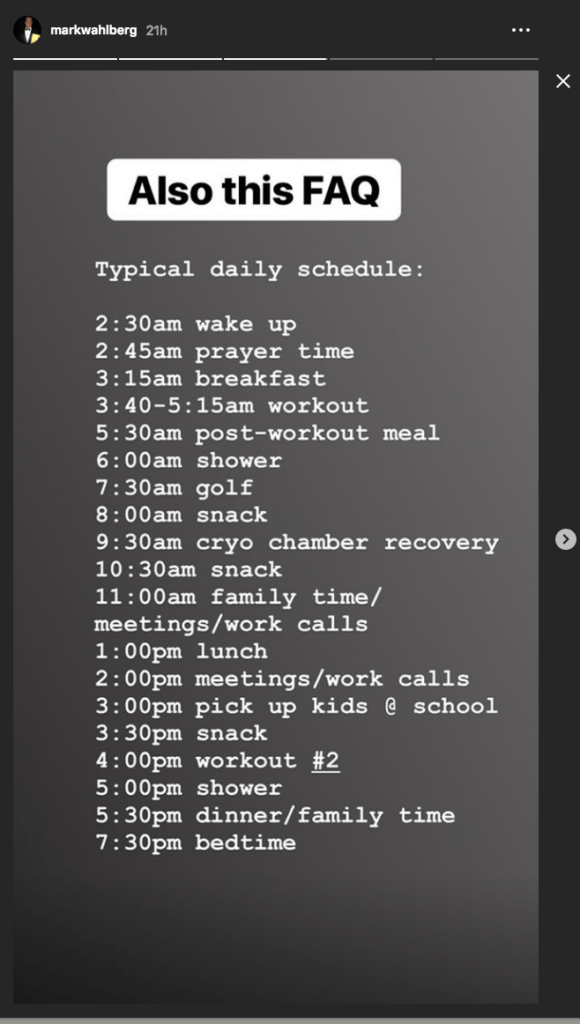
Okay, so, on paper it’s ridiculous, but nothing that should have ballooned, right? If your neighbours woke up at 2:30 to pray, it wouldn’t really be a blip in your day to day.
Oh, ye of little faith.
The schedule inspired this:
Mark Wahlberg's schedule my ass. Wait til you see mine. pic.twitter.com/8Oxji6AO5X
— Paddy Duffy (@PaddyDuffy) September 13, 2018
And also this:
Mark Wahlberg eat your heart out.. my daily schedule is another level ?? @markwahlberg ? pic.twitter.com/0o0OCyUqmQ
— Laura – StyleBuzz UK (@Laura_StyleBuzz) September 12, 2018
And this:
I never knew Mark Wahlberg and I had so much in common pic.twitter.com/inZ5ZUtili
— K? (@KateCooperOwen) September 12, 2018
People were baffled. And confused.
People were getting on the fake schedule train, and enjoying it to the fullest. No brands grabbed hold of this one and ran with it, but people loved it. So many articles were written by confused copywriters (ours was not one of them) trying to see if this schedule was actually something people-who-are-definitely-human could do. The overwhelming reaction was that yes, you could do it, but it wouldn’t be easy, and it would also be easier to do if you earned over $54 million in a year.
Identity Crisis
The best kind of food is breakfast food. On this, everyone is in agreement.
via GIPHY
International House of Pancakes is a breakfast restaurant. On this, everyone is in agreement, except IHOP.
Do us a favour.
Go on the IHOP website and click on ‘menu’. Scroll down – no, past the pancakes and the eggs and the bacons. Past the waffles, too. Scroll deeper. Further. Lose sight of what started this. Do you still remember your family, and friends? What light was?
And — there it is.
Steakburgers. IHOP sells burgers, which are not a breakfast food except at 2AM after a party and an existential crisis. Unfortunately, having ‘pancakes’ in their restaurant’s name basically meant that nobody was buying the burgers.
IHOP wanted to change this. That was why, in the summer of 2018, they rolled out the announcement that they were changing their name from IHOP to IHOB.
For 60 pancakin’ years, we’ve been IHOP. Now, we’re flippin’ our name to IHOb. Find out what it could b on 6.11.18. #IHOb pic.twitter.com/evSxKV3QmT
— IHOP (@IHOP) June 4, 2018
They were going from the ‘International House of Pancakes’, a family staple, to the ‘International House of Burgers’, an unknown and terrifying entity.
The change was not well received. Not only did IHOP attract a lot of this sort of attention:
#ihob #ihop #meme #memes #pancakes #pancake https://t.co/FD8HuByfsH pic.twitter.com/4FpeuKWo4j
— Princess Cadenza (@cadegorawrz) June 13, 2018
“Is this IHOP?”
“NO! THIS IS IHOb!!” pic.twitter.com/P0Ro6syGPA— Hunter Ford (@hfordchill) June 12, 2018
Back at it again with the disappointments #ihob pic.twitter.com/lbDKyA8uUF
— Carlos Can2 (@realCarlosCantu) June 11, 2018
But other restaurants also showed their beef with the name change:
LMAO BURGER KING PETTY AF pic.twitter.com/amh6s3UZ4H
— knife (@Knives_x) June 11, 2018
brb changing my name to Netflib
— Netflix (@netflix) June 11, 2018
Not really afraid of the burgers from a place that decided pancakes were too hard.
— Wendy's (@Wendys) June 11, 2018
Admittedly, it did push a lot of internet traffic towards IHOP, whether it was people scouring the website to meme it before the humour wore off, or avid pancake enthusiasts mourning their loss. Not only that, but the IHOP/IHOB conflict made it to the news.
The general consensus was that IHOB’s new direction was bound to end in tragedy and tears.
Weeks later, IHOP released a statement saying no, of course they weren’t changing their name permanently to IHOB, ha ha, don’t be silly – it was just a fun way to promote their new line of burger patties. Sceptical? So were we – IHOB’s name change was received so badly, and had so much backlash, that the only thing it could be was a misguided attempt to get hip with the teens.
It was not. Or maybe it was.
Either way, IHOP’s name-change quadrupled their sales and did what it intended to do: raise awareness about their steakburgers.
Blame it on the Australians
How much do you know about night-blogging?
‘Nothing’ is a perfectly acceptable answer, because night-blogging is kind of a niche Tumblr blogging type that only made it out into the wild web a few meme years ago. Night-blogging is nonsensical or absurdist text posts between the hours of 11PM and 5AM. It’s also known as Australian blogging (don’t tell Brendon or Vanessa, but we can see the correlation).
Literature students are particularly skilled at deciphering night-blogging. Two years of studying James Joyce and Derrida will do that to you.
Anyway, night-blogging: stupid, unconnected sentences that become absurdly funny when you’re reading them at night. They’re great. Everyone loves them.
Here’s an example of a Denny’s tumblr post:
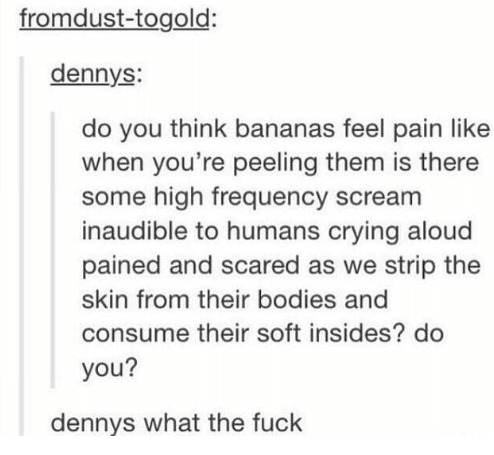
Now you see where we’re going with this.
Denny’s tumblr launched in 2013, and initially only posted funny memes generated from other users. They commented a lot on breakfast posts, and wrote about what they knew.
Then, in 2015, the night-blogging started, and subsequently, Denny’s tumblr took off like a rocketship (filled with pancakes). Tumblr users were delighted, or at the very least perplexed enough to interact with the restaurant and see what they could shake out of the syrup bottle. Responses ranged from the vaguely understandable:

To the WTF:
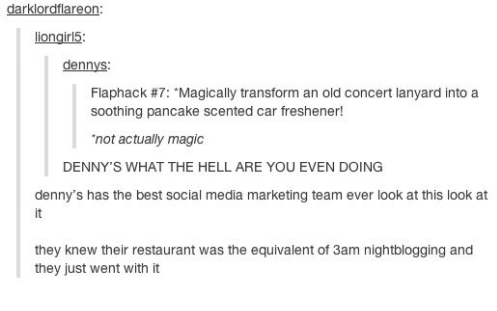
The attempt? Bring the real-life Denny’s booth – a repository for strange conversations, notable strangers, and weird encounters – into the cyber-life, and market to audiences using the voice of the medium. Denny’s tumblr has 40,000 followers, with most of those followers engaging with the brand purely because they are interested to see what they’re going to come up with next.
The virality of Denny’s was short-lived: only a brief, liminal, wondrous period of time blasted Denny’s all across the internet, but the handoff is continuous engagement through the form of followers who came for the jokes and stayed for the long-run.
So what do you notice about virality?
This has been a long post up until now, so go make yourself a cup of tea and think about this: what do all of these posts have in common? Take your time – we’ll wait.
via GIPHY
Cosy?
Okay.
Here’s the thing: all of these brands went viral.
But, and here’s the other thing, they have absolutely nothing in common, except for the MERL and Denny’s being an institution that has put time and effort into humanizing itself to its user-base – but more on that in a later edition of Office Bloggers.
Back to what we were saying: They have nothing in common.
The MERL isn’t a rigorous schedule, Mark Wahlberg probably doesn’t eat at Denny’s, and IHOb/IHOP only exists in the US. There’s no reason why any of these should’ve been such a hit outside of their respective countries, why they transcended borders to take over the Internet for months at a time. Even months after, you can explain why some of the things were popular – Mark Wahlberg’s schedule, for example, is hysterical in a ‘more money than sense’ sort of way, and IHOP’s marketing failure/success would’ve definitely struck a chord with those who’d grown up with the institution – but other than that, where’s the humour? Where’s the immediate need to tell everyone about it? Where are the people talking about it now?
Some of the elements are similar – absurdist or funny content is more likely to go viral, for example, then sombre or serious content, but it isn’t an absolute formula. What we’re saying is that nobody can promise you viral content, and then deliver on that content, because attempting to mimic virality has historically not gone well in the past.
In a nutshell
Viral content just is. It could be posted, and waiting dormant on the internet for years before someone digs it up and sets it to the tune of the Dancing Spiderman. Every piece of content that has gone viral before 2019 has had nothing in common with the piece before: spiders georg, What the Fluff challenge, Google Arts & Culture selfies, night-blogging.
Going to a digital marketing agency and asking for viral content is the same as going to McDonalds and asking for a burger: you’ll get something that looks like it, but it won’t be what you want, and it won’t taste as good as what you imagined.
Stop asking for viral content.
Instead, ask for content that engages. Ask for content that’s interesting, and fun, and will start conversations. Think outside of the box. Make jokes, about yourself, about others, about everything you can think of. Let go of professionalism – viral content is not going to be professional content.
Enjoy telling your stories.
And stop asking for viral content. It doesn’t work.

